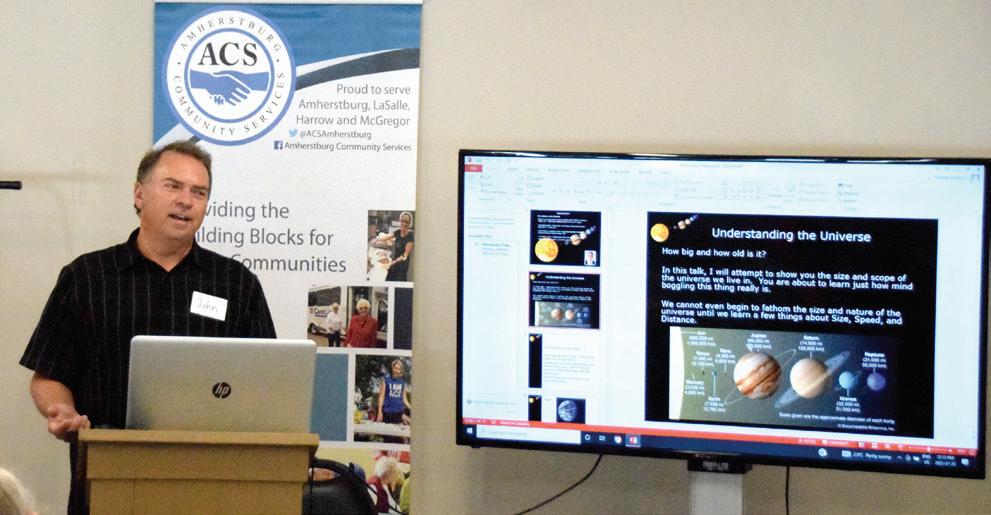
2 minute read
Local astronomer shares his knowledge at ACS’ “Feast with Friends”
By Ron Giofu
A local not-for-profit agency brought in someone with a knowledge of the stars to educate those who turn out for one of their luncheon events.
Amherstburg Community Services (ACS) presents its “Feast with Friends” lunch with local seniors with the meal being served every other Thursday at ACS’ community room at 320 Richmond St. The most recent event featured local realtor John Bondy, who is also an astronomer with a knowledge of the stars.
The presentation came exactly 54 years to the day of when man landed on the moon.
Bondy has spent much of his life studying the planets, stars, galaxies and universe, and is also a member of the Royal Astronomical Society of Canada – Windsor Chapter. His presentation featured his own knowledge, including items he learned from the book “Night Watch” by Terrance Nicholson.
“We cannot even begin to fathom the size and nature of the universe until we learn a few things about size, speed and distance,” said Bondy.
Among the facts presented during Bondy’s presentation was that the sun is the nearest star and is massive compared to the Earth.
“It would take 1.3 million Earths to fill up the sun,” Bondy stated. “We could also say the sun is 1.3 million times larger than the Earth.”
According to Bondy, the sun is about halfway through its lifecycle. He said in about 5.5 billion years, it will run out of hydrogen fuel and start the expand and cooldown process.
But compared to other stars in the cosmos, the sun is considered “only an average-sized star,” said Bondy. Bondy also outlined the meaning of the speed of light, stating a light year is the distance that light travels in one year. He said light travels approximately six trillion kilometres in one year.
“When astronomers say an object is 4.3 light years away, they are saying the distance between Earth and the object is 4.3 years of doing the speed of light to get there,” said Bondy. “Many scientists believe we will never have the technology to ever come close to the speed of light, let along surpass it. They believe that TV shows like Star Trek and Star Wars are and always will be fiction and hype. I say I wonder how many people that lived in the late 1800s ever could have thought that man could travel and walk on the moon. Then, a little over seven decades later, Neil Armstrong stepped onto the surface of the moon.”
Bondy’s presentation attempted to show the size and scope of the universe in 11 steps. Information presented by Bondy included the fact the distance from the Earth to the moon is approximately 384,500 kilometres, adding it took astronauts two days to get there in 1969.
Whereas it takes the Earth 365 days to orbit the sun, it takes Mercury just 88 days. Bondy added it takes 224.7 days for Venus to go around the sun with Mars taking 687 days. It takes 11.86 years for Jupiter to orbit the sun, Saturn 29.46 years, Uranus 84 years, Neptune 164.8 years and Pluto 248 years.
“The supercluster that we belong to is the Virgo galaxy supercluster,” he said.
ACS’s “Feast with Friends” is $9 to attend and runs from 11 a.m.-1 p.m. with the next one scheduled for Aug. 3 featuring Park House Museum curator Stephanie Pouget-Papak speaking on “Fashion over the Years.”
For more information, call 519-736-5471.










